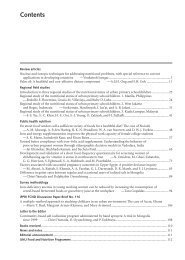From Invisible to Visible - Positive Deviance Initiative
From Invisible to Visible - Positive Deviance Initiative
From Invisible to Visible - Positive Deviance Initiative
Create successful ePaper yourself
Turn your PDF publications into a flip-book with our unique Google optimized e-Paper software.
xxiv See Lukes, S. (1985). Emile Durkheim: His Life and Work, a His<strong>to</strong>rical and Critical Study. Stanford<br />
University Press.<br />
xxv Durkheim is especially credited with making the study of sociology a science.<br />
xxvi The study of social networks have been used widely, both as theory and method, by sociologists, anthropologists,<br />
sociolinguists, geographers, information scientists, organizational scholars, economists, biologists,<br />
and others (Valente, 1995). Epidemiologists have used social network mapping <strong>to</strong> understand how patterns<br />
of human contact aid or inhibit the spread of diseases in a population. The well-known study on identifying<br />
Gaëtan Dugas, a French-Canadian airline steward, as “Patient Zero” for the transmission of HIV/AIDS in<br />
North America was a study that mapped social networks (Rogers, 1995). The study found that at least 40<br />
of the 248 people diagnosed with AIDS in the U.S. by April 1982 were thought <strong>to</strong> have had sex either with<br />
him or with someone who had. See Valente, T. W. (1995). Network Models of the Diffusion of Innovations.<br />
Cresskill, NJ: Hamp<strong>to</strong>n Press; and Rogers, E. M. (1995). Diffusion of Innovations (4 th ed.). New York: The<br />
Free Press.<br />
xxvii Along with a dense core, the loose peripheries are key as they signify “weak interpersonal ties”<br />
(Granovetter, 1973). Weak ties are more likely <strong>to</strong> introduce new ideas <strong>to</strong> network members than close ties.<br />
For instance, a group of friends who only do things with each other already share the same knowledge and<br />
opportunities. However, those with connections <strong>to</strong> other social worlds are likely <strong>to</strong> have access <strong>to</strong> a wider<br />
range of information. In essence, informationally, it is better for individuals <strong>to</strong> have connections <strong>to</strong> a variety<br />
of networks rather than many connections within a single network. See Granovetter, M. (1973). The<br />
strength of weak ties. American Journal of Sociology, 78, 1360-1380.<br />
xxvii On account of her training in microbiology<br />
39

















